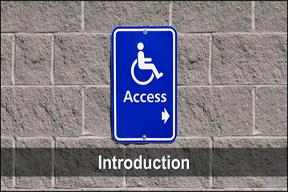
ADA Guidelines 2010: Small Towns
People with disabilities continue to face architectural barriers that limit or make it impossible to access events or services. The American Disability Act (ADA) gives people with disabilities an equal opportunity to participate in the mainstream of public life offered to all Americans. The ADA’s regulations and the ADA Standards for Accessible Design, originally published in 1991, set the standard for what makes a facility accessible. While the updated 2010 Standards retain many of the original provisions in the 1991 Standards, they do contain some significant differences. The Americans with Disabilities Act/Architectural Barriers Act Accessibility Guidelines (2010 Guidelines) developed by the U.S. Architectural and Transportation Barriers Compliance Board (the Access Board) effectively replaces the 1991 ADA Accessibility Guidelines (ADAAG) and the Uniform Federal Accessibility Standards (UFAS). This course specifically explores ADA compliance for small towns. Small towns offer a variety of essential programs and services that are fundamental to the public and to everyday American life. Although the range of services offered by small towns varies, it is essential that people with disabilities have the opportunity to participate in the programs and services that towns offer.
This course presents an overview of some basic ADA requirements and provides cost effective tips on how small towns can comply with the ADA. The information in this course comes from various resources. These resources include documents and illustrations from publications released by the ADA National Network, the U.S. Access Board, and the U.S. Department of Justice. This course provides practical information on how to comply with the Americans with Disabilities Act, to clarify potential misunderstandings about the requirements of the ADA, and to highlight its flexible, common sense approach to accessibility.
Request a demoCourse Details
Learning Objectives
At completion of this course, you will be able to:
- Comprehend different types of physical and mental disabilities as covered by ADA
- Recognize the revised regulations for Title II and Title III, the organization of the new design standards, and the standard’s intent to improve access and compliance
- Comprehend changes to the ADA as it relates to a small town’s programs and services
- Recognize the timeline for compliance with the 2010 ADA Standards for Accessible Design
- Comprehend the importance of compliance with the ADA
Specs
| Course Level | Intermediate |
| Languages | English |
| Compatibility | Audio, MobileReady |
Course Applies To
Demos + Pricing
Learn more about our courses, get pricing, and see our platform.











